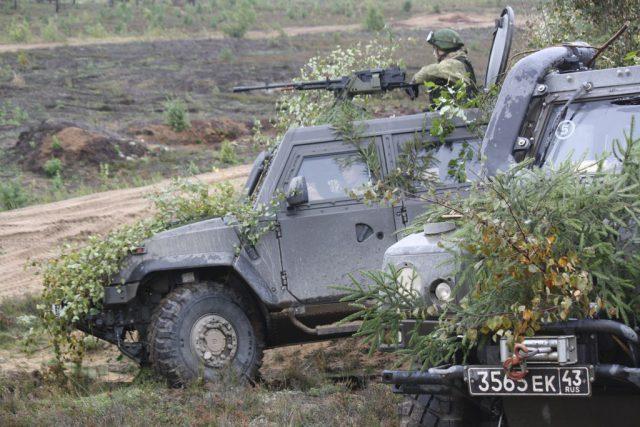
At a time when NATO–Russia relations are arguably at their lowest ebb since NATO’s bombing of Yugoslavia in 1999, major military exercises are designed to send a message. Russia’s Zapad 2017 military manoeuvres, which took place from 14 to 20 September in Belarus, parts of Western Russia, and the Russian enclave of Kaliningrad, proved to be no different. The secrecy that cloaked this year’s Zapad not only made the manoeuvres appear more threatening, but highlighted once again the competing values that have long plagued NATO–Russia relations.
Moscow sought to calm its neighbours, calling the war games that pitted Russian and Belarussian forces against fictional Western nations ‘absolutely defensive in nature’. In the words of Russian deputy defence minister Alexander Fomin, the primary aim was to practice combatting ‘terrorism’—featuring a scenario that simulated repelling a terrorist attack on Belarus.
Ukraine, and the NATO members that share a border with Belarus—namely, Poland, Lithuania and Latvia—saw the muscular posturing differently. There were fears that Russia wouldn’t withdraw its troops from Belarus, or that the manoeuvres could be used as a smokescreen to assault neighbouring countries—especially Ukraine.
Zapad 2017 didn’t come close to delivering the alarmist scenarios some media outlets offered, but it’s worth studying because of what it reveals about Moscow’s thinking.
Over the past decade, Russia has demonstrated a willingness to break the OSCE’s (Organisation for Security and Co-operation in Europe’s) Charter of Paris and its guiding principles for the post–Cold War period; that is, respecting a country’s sovereignty and territorial integrity and the inviolability of its borders. Russia’s invasion of Georgia in 2008, annexation of Crimea in 2014, and ongoing involvement in the Donbass brazenly violated those norms.
While all nations have the right to exercise their forces, there’s an expectation that those within the OSCE zone will adhere to the organisation’s confidence- and security-building measures. Under the OSCE’s 2011 Vienna document—which is a political agreement, not an international treaty—countries must provide six weeks’ notice for drills that involve more than 9,000 troops. For exercises involving 13,000 troops or more, they’re obliged to invite other OSCE countries to send observers. As one of the cornerstones of the Cold War security order, the agreement is designed to reduce the risk of misunderstandings that could lead to conflict.
To avoid extensive foreign monitoring, Russia declared the participation of just 12,700 troops. There’s enough open-source information, however, to conclude that the overall number of troops reached approximately 48,000. This isn’t the first time that Moscow has been accused of being ‘economical with the truth’. It increasingly takes advantage of the loophole under paragraph 10.3.3—a category not subject to the notification requirement—by conducting unannounced ‘snap’ exercises involving up to 100,000 troops. Between 2013 and 2017, Russia is said to have held 43 of these exercises.
Indeed, the Kremlin’s lack of transparency is at the heart of a much broader clash over the orientation of the post-Soviet states. As researchers from the Brookings Institution (PDF) explain, one of the fundamental points of contestation between the West and Russia centres on the status of countries like Belarus that were once Soviet republics. The West views them as sovereign nations, free to join Western institutions if they please, while Russia considers them part of its exclusive sphere of influence.
Ever since Russia’s annexation of Crimea, the government has put together a narrative to downplay the real cost of Western sanctions—insisting that isolation is actually good for Russia. Despite the Kremlin’s desire to reassert influence over its neighbours, it’s unlikely to reconstitute the Soviet Union anytime soon: the reality is that the Russian economy can no longer subsidise the former Soviet states. What the Kremlin wants instead is to deny its close neighbours the freedom to choose their own foreign-policy course.
The key purpose of Zapad, Emily Ferris writes in Foreign Affairs, ‘was for Russia to remind Belarus who the senior partner in the bilateral relationship is’. In purely strategic terms, Belarus is critical to Russia: the country’s pipelines carry a large chunk of the oil and gas that Russia sells to Western Europe. Because it is almost entirely dependent on subsidised Russian crude for its two oil refineries, Belarus is deep in Moscow’s orbit. Moscow, in turn, has used those subsidies to bolster its political influence. But with Moscow cutting its oil deliveries, and forcing Minsk to pay its debts, the relationship between Vladimir Putin and Belorussian president Alexander Lukashenko has come under increased strain.
Minsk may well be overdependent (PDF) on Russia financially, but its state institutions and foreign policy are not. For the country’s elites, the outbreak of hostilities in Ukraine raised fears that Belarus could someday be next. Since then, maintaining Belarus’ sovereignty has become a much more prominent part of Lukashenko’s foreign-policy agenda. On the war in Ukraine, the president has carved out a neutral stance, insisting that he would never allow Belarus to be used as a springboard to attack another state. And, more recently, he even rebuked Russian calls to establish a new air base on Belarussian territory.
In the current geopolitical environment, the Zapad exercises demonstrated the level of distrust that exists between Moscow and NATO members. The necessity of strengthening the Vienna document is beyond question, but the Kremlin still refuses to modernise the agreement. Until such steps are taken—which would go a long way to reassuring its neighbours—it appears that Russia is intent on turning the clock back to a time when great powers decided the fate of smaller nations and Europe was divided into spheres of influence.